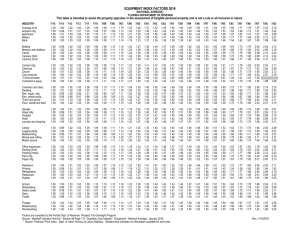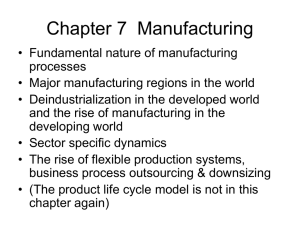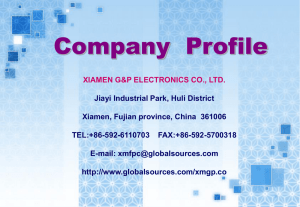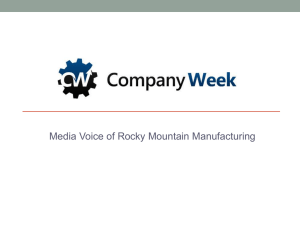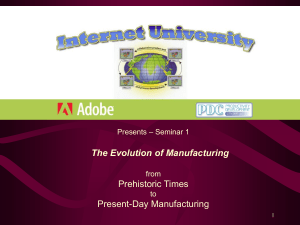Chapter 1: Introduction
advertisement
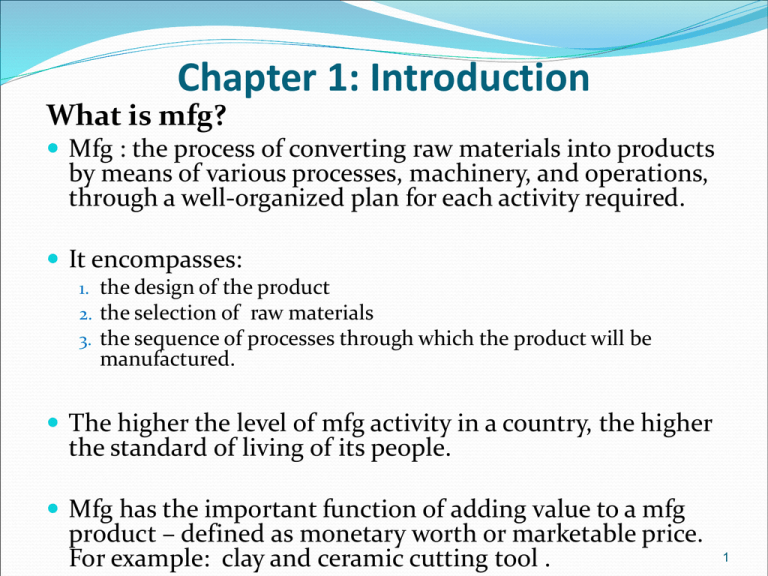
Chapter 1: Introduction What is mfg? Mfg : the process of converting raw materials into products by means of various processes, machinery, and operations, through a well-organized plan for each activity required. It encompasses: 1. the design of the product 2. the selection of raw materials 3. the sequence of processes through which the product will be manufactured. The higher the level of mfg activity in a country, the higher the standard of living of its people. Mfg has the important function of adding value to a mfg product – defined as monetary worth or marketable price. For example: clay and ceramic cutting tool . 1 Introduction Mfg activities must be responsive to several demands and trends: 1. A product must fully meet design requirements & products specs & 2. 3. 4. 5. 6. 7. standards. A product must be mfg by the most environmentally friendly & economical methods Quality must be built into the product at each stage. Production methods must be flexible enough to respond to changes in market demands, types of products, production rates, Quantities, and ontime delivery req. New developments in materials, production methods, and computer integration of both technological and managerial activities in a mfg org must constantly be evaluated with a view to their appropriate, timely, & economical implementation. Mfg activities must be viewed as a large system, the parts of which are interrelated. Such systems can be modeled, in order to study the effects of factors such as changes in market demands, prod design, and materials. Constantly strive for higher levels of quality and productivity. Output per employee per hour in all phases must be max. Zero-based part rejection are also an integral aspect of mfg 2 Example of mfg product: Paper clip What type of material? Metallic or non metallic? If metal what kind of metal? If the mat you start with is wire, what should be its diam? Should it be round or have some other x-section? Is the wire’s surface finish & appearance important? What should it be its roughness? How would you take a piece of wire & shape it into a paper clip? Would you do it by hand? If not , what kind of machine should you design or purchase to make paper clips? If, as the owner of a comp, you were given an order for 100 parts vs for a million parts, would your approach to mfg be diff? Design requirements: Function: hold pieces of paper …. Mat selected must have a certain stiffness & strength. If the yield stress is too low, the clip will bend permanently Stiffness also depends on wire diameter Style, appearance, and surface finish 3 Example of mfg product: Paper clip Material Selection Material selection requires knowledge of function and service requirements of the product. Therefore, choosing materials that are commercially available. Corrosion resistance must also be considered Questions regarding prod of paper clip: Will the mat selected be able to undergo bending during mfg without cracking or breaking? Can the wire be easily cut from a long piece without causing excessive wear on tooling? Will the cutting process produce a smooth edge on the wire or it will leave a burr? What is the most economical method of mfg this part at the desired prod rate? 4 The design process & concurrent engineering The design process for a product first requires a clear understanding of the functions & the performance expected of that product. The market for a product and its anticipated uses must be defined clearly. Product design is a critical activity: 70% to 80% of the cost of product development and manufacture is determined by the decisions made in the initial design stages. 5 Traditional product cycle Definition of product need: marketing information Conceptual design & evaluation: feasibility study Design analysis; codes/standards review; physical and analytical model CAD Prototype production: testing & evaluation Production drawings;; instruction manuals Material specs; process & equipment selection; safety review CAM & CAPP Pilot production Production Inspection & quality assurance CIM Packaging: marketing & sales literature Product 6 The design process & concurrent engineering Traditional product cycle While the traditional approach seems logical and straightforward in theory, it has been found in practice to be extremely wasteful of resources. For example, a mfg engineer may wish to taper the flange on a part to improve its castability or may decide that a different alloy is desirable. such changes necessitate a repeat of the design analysis stage, in order to ensure that the product will still function satisfactorily . these iterations, certainly waste resources, but more importantly, they waste time. 7 The design process & concurrent engineering Concurrent Engineering (CE) CE is a systematic approach integrating the design and mfg of products, with a view toward optimizing all elements involved in the life cycle of the product. Life cycle means that all aspects of a product, such as design, development, production, distribution, use, disposal, and recycling, are considered simultaneously. basic goals of CE: 1. reduce changes in product’s design & engineering. 2. reduce time and costs involved in taking the product form its design concept to its production and its introduction into the marketplace. 8 The design process & concurrent engineering A well-designed product is: 1. 2. 3. 4. 5. 6. functional (design) well-manufactured (production) well-packaged (distribution) durable (functions effectively for its intended life) maintainable (use) resource-efficient (can be disassembled so that components can be recycled-disposal) For CE to succeed, it must: 1. 2. 3. have the full support of upper management; have multifunctional and interactive teamwork, including support groups utilize all available technologies. Example of the benefits of CE: One automotive company has reduced No. of parts in one of its engines by 30%, and as a result has decreased that engine’s weight by 25% and cut its mfg time by 50% . 9 The design process & concurrent engineering CAD allows the designer to conceptualize objects more easily without having to make costly illustrations, models, or prototypes. Using CAE, the performance of structures subjected to static or fluctuating loads and to varying temperatures can now be simulated, analyzed, and tested more efficiently, accurately, and quickly than ever. Designs can be optimized, and modifications can be made, directly and easily, at any time. CAM: CNC of machines; programming robots for material handling & assembly, designing tools, dies, & fixture; & maintaining quality control. On the basis of the models developed using the foregoing techniques, the product designer selects and specifies the final shape & dimensions of the product, its dimensional accuracy and surface finish, and its component materials. The next step in the production process is to make and test a prototype. Tests of prototypes must be designed to simulate as closely as possible the conditions under which the product is to be used. During testing of prototypes, modifications in the original design, materials, or production methods may be necessary. After this phase has been completed, appropriate process plans, mfg methods, equipment, and tooling are selected, with the co-operation of mfg engineers, process planners, and others involved in production. 10 DFM, DFA, DFS DFM is a comprehensive approach to production of goods, and it integrates the design process with materials, mfg methods, process planning, assembly, testing, and quality assurance such that the product can be manufactured economically and efficiently Assembly is an important phase of the overall mfg operation and requires consideration of the ease, speed, and cost of putting parts together. Also, many products must be designed so that disassembly is possible, in order to enable the product to be taken apart for maintenance, servicing, or recycling of its components. Design for service, the goal of which is that individual parts or sub-assemblies in a product be easy to reach and service. The trend now is to combine DFM and DFA into the more comprehensive DFMA. 11 Selecting materials Types of materials used in mfg: 1. Ferrous metals. 2. Nonferrous metals. 3. Plastics: thermoplastics, thermosets, and elastomers . 4. Ceramics, glass ceramics, glasses, graphite, diamond. 5. Composite materials. 6. Nano-materials, shape-memory alloys, amorphous alloys, superconductors. Properties of materials When selecting materials for products: 1. consider their mechanical properties. 2. consider the physical properties of materials. 3. Chemical properties also play a significant role, both in hostile and in normal environments: Oxidation, corrosion, toxicity, and flammability. 4. Mfg properties of materials determine whether they can be cast, formed, machined, welded, & heat-treated with relative ease. Methods used to process materials to desired shapes can adversely affect product’s final properties, service life, & cost. 12 Selecting materials Cost and Availability The economic aspects of material selection are as important as tech. considerations of properties & chac. of materials. If raw or processed materials or mfg components are not available in the desired shapes, dimensions, and quantities, substitutes and/or additional processing will be required, and they can contribute significantly to product cost. A product design can be modified to take advantage of standard dimensions of raw materials and thus avoid extra mfg costs. Reliability of supply, as well as demand, affects cost. Different costs are involved in processing materials by different methods. Appearance, Service life, and recycling Color, feel, and surface texture. Time & service dependent phenomena such as wear, fatigue, creep, and dimensional stability are important. Friction & wear, corrosion, and other phenomena can shorten product’s life or cause it to fail permanently. Recycling of or proper disposal of component materials at the end of product’s useful service life for maintaining clean and healthy envir. Proper treatment and disposal of toxic wastes and materials. 13 Selecting mfg processes 1. 2. 3. 4. 5. Casting Forming and shaping. Machining. Joining. Finishing. Brittle and hard materials, for example, cannot be shaped easily, where-as they can be cast or machined readily by several methods. The mfg process usually alters the properties of materials. Metals that are formed at room temperature become stronger, harder, and less ductile than they were before processing. Dimensional accuracy and surface finish Size, thickness, and shape complexity of part have a major bearing on the mfg process selected to produce it. Flat parts with thin x-sections cannot be cast properly. Complex parts cannot be formed easily and economically, whereas they may be cast or else fabricated from individual pieces. Tolerances and surface finish obtained in hot-working operations cannot be as good as those obtained in cold-working operations. 14 Selecting mfg processes Operational and mfg costs The design & cost of tooling, lead time required to begin production, & the effect of wp material on tool life and die life are major consideration. For parts made from expensive materials, the lower the scrap rate, the more economical the production process will be. Availability of machines and equipment and of operating experience within the mfg facility are also important cost factors. No. of parts required and the required production rate are important in determining the processes to be used and the economics of production. Operation of machinery has significant environmental & safety implication. The safe use of machinery is another important consideration. 15 selecting mfg processes Consequences of Improper Selection of Materials & Processes A component or a product is generally considered to have failed when: 1. It stops functioning (broken shaft, gear, bolt, or turbine blade). 2. It does not function properly or perform within required specification limits (worn bearings, gears, tools, and dies). 3. It becomes unreliable or unsafe for further use (crack in a shaft, poor connection in a PCB). Product failures Result from: 1. design deficiencies 2. improper material selection 3. material defect 4. mfg-induced defects 5. improper component assembly 6. improper product use. Net-shape mfg The part is made, in the first operation, as close to the final desired dimensions, tolerances, surface finish , and specifications as possible. 16 Selecting mfg processes Computer Integrated Mfg The major goals of automation in mfg facilities are to integrate various operations so as to: 1. 2. 3. 4. improve productivity. increase product quality and uniformity. minimize cycle times. reduce labor costs. CIM is effective because of its capability for making possible: responsiveness to rapid changes in market demand and product modification better use of materials, machinery, personnel, & reduction in inventory. better control of production & management of the total mfg operation. the manufacture of high-quality products at low cost. 17 Computer Integrated Mfg CNC Adaptive Control (AC): parameters in a mfg process are adjusted automatically to optimize production rate and product quality and to min cost. Parameters are monitored constantly. If they move outside the acceptable range, the system adjusts the process variables until the parameters again fall within the acceptable range. Industrial robots: Replacing humans in operations that are repetitive, boring, and dangerous, thus reducing possibility of human error, decreasing variability in product quality, and improving productivity. Automated handling of materials. CAPP: this tool is capable of improving prod in plant by optimizing process plans, reducing planning costs, & improving the consistency of prod quality & reliability. Functions such as estimating of cost and the monitoring of work standards (time req to perform a certain operation) can also be incorporated into 18 the system. Computer Integrated Mfg JIT: supplies are delivered JIT to be used, parts are produced JIT to be made into sub- assemblies and assemblies, and products are finished JIT to be delivered to the consumer. In this way, inventory-carrying costs are low, part defects are detected right away, prod is increased, and high quality products are made at low cost. Cellular mfg. FMS: integrates mfg cells into a large unit, all interfaced with a central computer. FMS have the highest level of efficiency, sophistication, and prod among mfg systems. They are capable of efficiently producing parts in small runs and of changing mfg sequences on diff parts quickly; this flexibility enables them to meet rapid changes in market demand for various types of products. AI: use of machines & computers to replace human intelligence. Computer controlled systems are becoming capable of learning from experience & of making decisions that optimize operations and min costs. Artificial neural networks, which are designed to simulate the thought processes of human brain, have the capability of modeling & simulating production facilities, monitoring & controlling mfg processes, diagnosing problems in machine performance, conducting financial planning, and managing a company’s mfg strategy. Shared mfg. 19 Quality Assurance & TQM Quality is a char or property of several well defined technical (objective) and aesthetic (subjective) considerations. General public perception’s is that a high quality product functions reliably and as expected over a long period of time. Traditionally, QA has been obtained by inspecting parts after they have been mfg. Parts are inspected to ensure that they conform to a detailed set of specs and standards such as dimensions, surface finish, and mech & physical properties New approach: quality must be built into a product, from the design stage through all stages of mfg and assembly. The objective should be to control processes, not products. low quality products do not necessarily cost less to mfg than high quality products do. Product integrity Product integrity is a term that can be used to define the degree to which a product 1. 2. 3. 4. is suitable for its intended purpose. Fills a real market need Functions reliably during its life Can be maintained with relative ease Product integrity has also been defined as the total product experience of the customer, or as the totality of qualities needed to conceive, produce, and market the product successfully 20 Quality Assurance & TQM TQM and QA TQM and QA are now the responsibility of everyone involved in designing and mfg a product. The major goal is to prevent defects from occurring, rather than to detect and reject defective products after they are made. QA standards ISO 9000 series on quality management and QA standards, as well as QS 9000. A company’s registration for this standard, which is a quality process certification and not a product certification, means that the company conforms to consistent practices as specified by its own quality system. DFMA and concurrent engineering: The design should make the product as simple as possible to mfg, assemble, disassemble, and recycle. Mat should be chosen for their appropriate mfg char. Dim accuracy and surface finish should be specified as broadly as is permissible, in order to minimize mfg costs. Secondary and finishing operations on parts should be avoided or minimized, because they can add significantly to cost. 21 Global Competitiveness & mfg Costs Total cost of mfg a product Consists of the costs of mat, tooling, and labor, the fixed costs, and capital costs. Mfg costs can be min by analyzing the product design to determine whether the part size and shape are optimal and whether the mat selected are the least costly ones that possess the desired properties and char. Tooling costs depend on: 1. 2. 3. 4. Complexity of part shape Material involved mfg process The no. of parts to be made. Direct labor costs are usually only a small % of the total cost (10-15% ). The trend toward increased automation and toward computer control of all aspects of mfg helps to min labor involvement and so to reduce direct labor costs. Fixed costs and capital costs depend on the particular mfg and plant facilities. 22 Lean Production and Agile mfg Lean production (LP) LP involves a major assessment of each of the activities of a company: efficiency & effectiveness of its various operations. possibility of dispensability of some of its operations & managers efficiency of machinery and equipment in the operation. No. of personal involved in each particular operation. It continues with a thorough analysis of the costs of each activity, including those due to productive and non-productive labor. This concept req a fundamental change in corporate culture as well as understanding of the importance of cooperation & teamwork between management and the work force. Its results do not necessarily req cutting back to resources, rather it aims at continually improving the efficiency & profitability of the company, by removing all waste from the operations and by dealing with problems right away. Agile mfg (AM) The use of the principles of LP on a broad scale. The principle behind AM is ensuring agility, hence flexibility, in the mfg enterprise, so that it can respond quickly to changes in product demand and in customer needs. This flexibility is to be achieved through people, equipment, computer hardware and software, and sophisticated comm. Systems. (3W) 23 Environmentally Conscious Design & Mfg Environmentally-Conscious Design and Mfg This approach anticipates the possible -ve environmental impact of mat, products, & processes, so that it can be taken into account at the earliest stages of design and mfg. Reducing waste of mat at their source, by refining in product design and by reducing the amount of mat used. The main objectives now are preventing pollution at the source and promoting recycling and reuse in place of disposal. Design for Recycling (DFR): Making improvements in recycling, in waste treatment, and in reuse of mat. Conducting research and development into environmentally-safe and into mfg technologies. Reducing the use of hazardous mat in products and processes Ensuring proper handling and disposal of all waste Product Liability Product liability: The consequences of a product’s malfunctioning and possibly causing bodily injury (or even death) and financial loss to a person or org Human factors engineering and ergonomic considerations are important aspects of the design and mfg of safe products. 24 Organization for Mfg Traditional Major responsibilities of Mfg engineers : plan the mfg of a product & the processes to be utilized. identify machines, equipment, tooling, and personal to carry out the plan. interact with design and mat engineers to optimize productivity and min production costs. cooperate with industrial engineers when planning for plantfloor activities, on such topics as plant layout, machine arrangement, selection of material-handling equipment, time & motion study, production methods analysis, production planning & scheduling, and maintenance. Traditional operational philosophy of mfg orgs: emphasis was on top-down comm. In the org and on strong control by management, with priorities for quick financial return (profits 1st) and growth and size (economy of scale). emphasized the business and financial aspects of a comp, keeping mfg subordinate to the overall marketing plan. 25 Organization for Mfg Modern operational philosophy of mfg orgs: broad-based comm. Across the org. Mfg has become an integral part of long-range business planning for companies that want to maintain their competitive positions and increase their market share. In order to respond to these major changes, it’s essential in a mfg org to: View people in the org as important assets. Emphasize the importance and need for teamwork and involvement in problem solving and in decision making processes in all aspects of operations. Encourage product innovation and improvements in productivity. Relate product innovation and mfg to the customer and to the market. The product must be seen as meeting a need Increase flexibility of operation for faster response to product demands. Encourage efforts for continuous improvement in quality (quality 1st). customer satisfaction. 26
